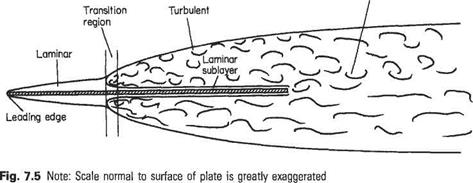Growth along a flat surface
If the boundary layer that develops on the surface of a flat plate held edgeways on to the free stream is studied, it is found that, in general, a laminar boundary layer starts to
|
Wake
|
develop from the leading edge. This laminar boundary layer grows in thickness, in accordance with the argument of Section 7.2, from zero at the leading edge to some point on the surface where a rapid transition to turbulence occurs (see Fig. 7.29). This transition is accompanied by a corresponding rapid thickening of the layer. Beyond this transition region, the turbulent boundary layer then continues to thicken steadily as it proceeds towards the trailing edge. Because of the greater shear stresses within the turbulent boundary layer its thickness is greater than for a laminar one. But, away from the immediate vicinity of the transition region, the actual rate of growth along the plate is lower for turbulent boundary layers than for laminar ones. At the trading edge the boundary layer joins with the one from the other surface to form a wake of retarded velocity which also tends to thicken slowly as it flows away downstream (see Fig. 7.5).
On a flat plate, the laminar profile has a constant shape at each point along the surface, although of course the thickness changes, so that one non-dimensional relationship for м = f{y) is sufficient (see Section 7.3.4). A similar argument applies to a reasonable approximation to the turbulent layer. This constancy of profile shape means that flat-plate boundary-layer studies enjoy a major simplification and much work has been undertaken to study them both theoretically and experimentally.
However, in most aerodynamic problems, the surface is usually that of a streamline form such as a wing or fuselage. The major difference, affecting the boundary – layer flow in these cases, is that the mainstream velocity and hence the pressure in a streamwise direction is no longer constant. The effect of a pressure gradient along the flow can be discussed purely qualitatively initially in order to ascertain how the boundary layer is likely to react.












